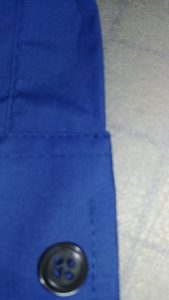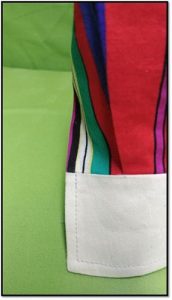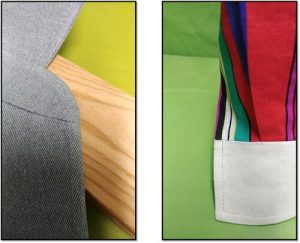What does it mean when pattern instructions say to press open the seam? This short video will tell you what you need to know.
Learn to Sew: Removing Stitches
As we sew, so shall we rip. Removing parts of seams is a normal part of sewing. Through this short video, learn how to properly remove stitches from a seam so as not to cause any damage to the fabric.
Sewing a Collar Band/Stand and Cuff
 Last week I told you I’d share my final blog of the year with another new sewing technique I’ll be sharing with members.
Last week I told you I’d share my final blog of the year with another new sewing technique I’ll be sharing with members.
I have been frustrated all my sewing life with the way cuffs are done. The intersection between the placket and cuff are not smooth and even. This, and the collar stand, had been my sewing nemesis for many years. Sometimes patterns would come out with new techniques which would be better—like the “burrito” technique—but I still wasn’t happy with the results. Have you been happy with your results? Was the transition smooth with the way you’ve been doing them?
 It took a lot of trial and error many years ago, long before I came on board with ASG, but I came up with a method of sewing these garment areas that finally made me happy. I’ve never put either into writing until now.
It took a lot of trial and error many years ago, long before I came on board with ASG, but I came up with a method of sewing these garment areas that finally made me happy. I’ve never put either into writing until now.
I’m working on finalizing the instruction and in the beginning of 2018 ASG members will get my full instructions. I’m hoping this will be a game-changer for beginning and advanced sewers alike. I think part of our problem with sewing is not getting really pretty results which scream homemade. Why, even ready-to-wear garments don’t have a smooth transition though better quality and custom ones are much, much better but they still don’t use the technique I developed.

I’ve not seen the way I do a collar band/stand and cuff written anywhere. I’m hoping by putting these in writing for our members it will be my little way of changing the sewing world and the way sewing is done in these areas giving sewers better outcomes in their construction.
If you would like these instructions, please join ASG and you can get them online in our educational videos.
Here’s to a happy journey of sewing in 2018!
~Ramona
The Plight of (sewing) Intersections
Do you read pattern sewing instructions and wonder why someone hasn’t come up with a better system of sewing some areas of garments? I often do that. Specifically right now I’m talking about the intersection of the collar stand and cuff on a sleeve.
Here the front of the shirt front is folded back twice and stitched down. The collar stand is attached, with the collar, and at the center front it is anything but pretty and as near perfect as we can get it. I see this in not only home sewn garments but also in ready-to-wear like this shirt. When fabrics are thin, it is easier to get a somewhat smooth transition from the front band into the collar stand, but on heavier fabrics like denim it is much harder because of the bulk of the fabric and all the layers that come together at that point.
Example 2
 The same with a cuff with a placket. Again, with a lighter weight fabric like a shirting, the layers that come together aren’t as bulky as a heavier fabric, yet—there is still an anything but smooth transition.
The same with a cuff with a placket. Again, with a lighter weight fabric like a shirting, the layers that come together aren’t as bulky as a heavier fabric, yet—there is still an anything but smooth transition.
In better ready-to-wear greater care is taken in these two areas making them smoother but still, it is not as perfect as I’d like.
After considerable thought and a lot of experimentation, I believe I’ve come up with what I think is a good way to transition these areas. Will it change the world of sewing? I’d like to think so! Honestly, all it takes is a little re-designing of the pattern and different steps in construction but truly it is no harder than matching seamlines at a center back waist.
I’m finishing up a garment now that will have these two new techniques in it. They will be in the video sew-along series and posted on the ASG website in the members only area. The video will show step by step how each is accomplished.
Watch for the last blog of the year next week and I’ll show you the final garment areas and you can judge for yourself.
Sew ‘til next time….enjoy the journey of sewing!
~Ramona
Permission to Fit!
Garment Fitting
Home sewers and most educators approach fitting so differently it is no wonder it is so confusing. I like a combo of flat pattern alteration with the tweaking done in draping on the body. There is so much that plays into fitting from body structure, weight distribution, physical attributions and limitations, fabric type, the fabric weave, the fabric’s weight, and it’s stretch or lack of, and just how the wearer just personally likes a garment to “fit” them. And then of course, there is the pattern–how much is fit, how much is “design ease” or the silhouette of the garment (think mermaid skirt to a full-flowing ball gown skirt). Unfortunately, fitting is not a one-solution method, but what I will tell you is that most of us “over-think” it and make it much harder than it is.
Garment Structure and Undergarments
Remember the corsets and girdles of the last two centuries and more? Body parts were held firmly in place and supported. Fleshy portions of the waist and hip were smoothed out. Undergarments need to support areas of the body and most of us today want comfort over support. Wear a sports bra under a business jacket and guess what? The bust darts won’t shape as they should, there most likely will be wrinkles in the garment under the bust down to the waistline–the fabric will puddle like a drapery on the floor. Bust darts won’t point to the bust apex, and the garment generally just won’t fit right. Want a great fitting garment? Start with proper foundation garments.
Padding
In teaching classes on fit I always get push-back on “padding” out areas − like using shoulder pads. A dress or blouse “hangs” from the shoulders. If the shoulders aren’t supported, the garment isn’t supported. Padding also “evens out” uneven areas–and our goal is to make the garments we make look “balanced” (pad out a lower shoulder to equal the other). I think most envision “Linda Evans” ’80’s shoulder pads. That is a style. What I’m talking about are at least 1/4″ – 3/8″ shoulder pads that help support the garment from the shoulders and giving a smooth look. Take shoulder pads out of the equation on a garment requiring one, guess what? You’ll have drag wrinkles, a wimpy upper chest on the garment, sleeves that may twist at the cap, and just an ill-fitting garment.
Confidence
I’ve discovered people basically know what they like in fit, but they are not confident they are “right.” Home sewers are so concerned about doing things the “right” way. Well, I’m here to tell you, that the “right” way often boxes us into a corner and the project then becomes a UFO. Feel free to give yourself permission to do what YOU think is right—because guess what, it probably is! Body measurements to the flat pattern translate into a 3-D fabric garment. Add length and width where it is needed, not just at the seams. There might be more width in the bust area from the apex to the side seam, but not from the apex to the center front, or vice versa. Add more fabric where needed, and take it out where it is not needed, being mindful of the fabric grainline.
That’s how I’ve developed some of the things I do that are out of the norm or not considered the “right” way to do things. Those are my “AH HA!” moments. For a long while I’ve been contemplating something about pattern alteration and fitting and hopefully sometime soon I’ll start experimenting. Who knows, maybe it will lead to a whole new way to think about flat pattern alteration and fitting.
Sew until next time… enjoy the journey of sewing!
~Ramona
- « Previous Page
- 1
- …
- 75
- 76
- 77
- 78
- 79
- 80
- Next Page »






